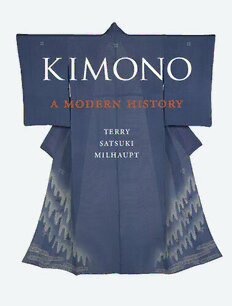
Kimono: A Modern History PDF
Preview Kimono: A Modern History
k imono terry satsuki milhaupt Kimono k imono terry satsuki milhaupt REAKTION BOOKS To Chie, Tsuru, Grace, Joyce and Karen Published by Reaktion Books Ltd 33 Great Sutton Street London ec1v 0dx, uk www.reaktionbooks.co.uk First published 2014 Copyright © Terry Satsuki Milhaupt 2014 e publishers would like to thank e Great Britain Sasakawa Foundation for its support in the publication of this work All rights reserved No part of this publication may be reproduced, stored in a retrieval system, or transmitted, in any form or by any means, electronic, mechanical, photocopying, recording or otherwise, without the prior permission of the publishers Printed and bound in China on acid-free paper by C&C offset printing Co., Ltd. A catalogue record for this book is available from the British Library iSBN978 1 78023 278 2 C oNTeNTS iNTRoduCTioN 7 One The FouNdATioNS oF A KiMoNo FAShioN iNduSTRy 31 Two ModeRNiziNG The KiMoNo 56 Three ShoPPiNG FoR KiMoNoS, ShAPiNG ideNTiTieS 97 Four The KiMoNo ideAL MiGRATeS WeST 139 Five KiMoNo deSiGNeRS 179 Six eveRydAy ANd exTRAoRdiNARy, TheN ANd NoW 229 References 249 Bibliography 275 Acknowledgements 287 Afterword 289 List of Illustrations 291 Index 303 i NTRoduCTioN Recognizable by its T-shaped outline, fluttering sleeves and flowing vertical panels draped from the wearer’s shoulders, the kimono embodies Japan, real and romanticized, familiar and foreign. in the popular imagination, the kimono often represents an unchanging, tradition-oriented, eternal Japan. But how and when did the identification of the kimono as Japan’s national costume occur? Why is the kimono more closely associated with the female than the male body? What processes led to the transformation of the kimono from an everyday garment to an icon of Japan? A review of the clothing worn by models on the covers of ‘Ladies’ Companion’ (Fujin no Tomo), one of Japan’s leading twentieth-century women’s magazines, provides a visual barometer of shifting post-Second World War attitudes towards the kimono. of the women featured on the covers from 1949 to 1956, more are shown wearing Western-style clothing than Japanese. From 1957 to 1962, the models themselves appear more cosmopolitan, their hair colour becoming lighter and lighter until it is rendered almost blonde and their facial characteristics more closely resembling Caucasian rather than Asian features. From 1967 to 1992, only one or two covers per year feature a woman wearing a kimono. however, without exception, the first issue of every year depicts a woman wearing a formal kimono ensemble. us, from the late 1960s until the early 1990s, the kimono was primarily promoted as a costume suitable for special occasions such as New year’s celebrations or Adult day ceremonies held in January, linking the kimono more closely with ‘tradition’ rather than ‘fashion’.1 visual artefacts such as the covers of ‘Ladies’ Companion’ reveal how the T-shaped silk kimono came to take on a symbolic meaning in the second half of the twentieth century. valued as a ceremonial garment and national costume, it continues to be worn in its traditional form for special occasions. however, since the beginning of the twenty-first century, women from a new generation have started to be drawn to it for less formal, more fashion- oriented reasons. To this younger generation of women, the clothing that their grandmothers and even their mothers might refer to as yōfuku, or 7 kimono ‘Western-style’ clothing, is as familiar as it is to their American and european 1 Cover of Utsukushii contemporaries. To a select group within this younger generation, the kimono Kimono(Spring 2003), published by hachette is an appealing alternative to the clothing they grew up with. in contrast Fujin Gahō. to their mothers and grandmothers, who favoured newly manufactured, 2 Cover of Kimono Hime classic kimono fashions, some of today’s younger generation prefer vintage, (April 2003), published second-hand kimonos. Aware of the generational differences among kimono by Shotensha. consumers, magazine publishers now cater to particular market segments. in 2003, 50 years after the publisher Fujin Gahō released the first issue of ‘Beautiful Kimono’ (Utsukushii Kimono), a new magazine called ‘Kimono Princess’ (Kimono Hime) hit the news-stands. Whereas ‘Beautiful Kimono’ had emphasized classical and high-end kimonos worn primarily by women in their forties, fifties and sixties, the new publication focused on a younger market(illus. 1, 2). e title Kimono Hime, written with the word ‘kimono’ in romanized letters (which are usually reserved for foreign words), followed by the Chinese character for ‘princess’ (hime) targeted the newly emerging, kimono-buying women in their twenties and thirties. Kimono Himeempha- sized a new ‘kimono look’ that often featured the brightly coloured, bold patterns popular in the 1920s and ’30s, styled in edgy, unconventional combinations. Reflecting contemporary trends, the kimonos featured on the pages of Kimono Himeare not exclusively promoted as ceremonial wear, but rather are 8
